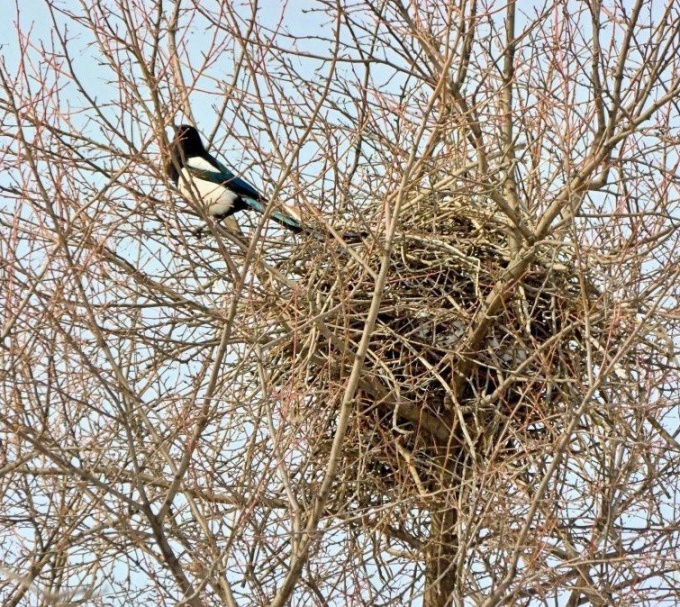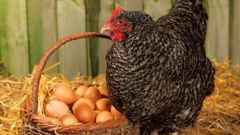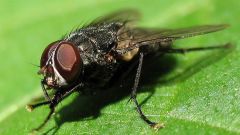The magpie is easily recognised by its plumage. The body and breast of a bird blue-black, with tints, in some species, on the chest is the so-called apron in white. Wings of the magpie's long, thin, on the edge of the feathers on them and the tail has a white fringe. Place of residence and nesting magpies – a forest of any type, but it often settles near human habitation, bringing a lot of trouble to their neighbors. It is noteworthy that this bird is highly intelligent, able to remember information easily adapts to any living conditions, cope with emergencies and intuitively feels danger or a friendly attitude.
Few people know that forty is kind of the antithesis of the cuckoo, which is engaged in the education of their offspring and just throws eggs in the wrong nest. Forty, on the other hand, stealing someone else's eggs and carries to its nest.
Before laying eggs, magpie builds the nest, and their number reaches up to 10 pieces, from which it then choose one. The construction of the nest of the magpie is quite complicated – it's a tough construction in the form of bowls, and sometimes the ball with a side entrance, filled with soft bed of feathers, moss and leaves, wool and dry grass.
One clutch of magpies is 7-8 eggs, which she extracts for 18 days. After hatching, the light pair for a long time, nursed them, as they are absolutely helpless, and the science of self-survival and adaptation to digest with difficulty. The period of growth of young animals may be more than 4 weeks.
To lay eggs before the magpies start other birds, in April or early may. To ensure the safety of future offspring, these birds formed a flock, the nests of which are very close. Males engaged in the protection of "territory", and while one group of them is responsible for the protection, the other to forage females and juveniles. Magpies are able to make reserves of food, which they hide in small depressions in the ground near the nest-like structure.
Magpies are omnivores – they love to eat insects and small lizards, often ruining other people's nests, some eggs of which moves in its clutch, and the part eaten. For their Chicks magpies constitute a menu and alternate food products of animal origin with plant seeds, sprouts and leaves.
Despite the almost unanimous view that the magpies are not useful, nature needs them. During activation of ticks, for example, they help large animals to get rid of them, collecting them not only with skin, but pulling those that have already managed to sink her.
Like a magpie breeds
Few people know that forty is kind of the antithesis of the cuckoo, which is engaged in the education of their offspring and just throws eggs in the wrong nest. Forty, on the other hand, stealing someone else's eggs and carries to its nest.
Before laying eggs, magpie builds the nest, and their number reaches up to 10 pieces, from which it then choose one. The construction of the nest of the magpie is quite complicated – it's a tough construction in the form of bowls, and sometimes the ball with a side entrance, filled with soft bed of feathers, moss and leaves, wool and dry grass.
One clutch of magpies is 7-8 eggs, which she extracts for 18 days. After hatching, the light pair for a long time, nursed them, as they are absolutely helpless, and the science of self-survival and adaptation to digest with difficulty. The period of growth of young animals may be more than 4 weeks.
Interesting facts about magpies
To lay eggs before the magpies start other birds, in April or early may. To ensure the safety of future offspring, these birds formed a flock, the nests of which are very close. Males engaged in the protection of "territory", and while one group of them is responsible for the protection, the other to forage females and juveniles. Magpies are able to make reserves of food, which they hide in small depressions in the ground near the nest-like structure.
Magpies are omnivores – they love to eat insects and small lizards, often ruining other people's nests, some eggs of which moves in its clutch, and the part eaten. For their Chicks magpies constitute a menu and alternate food products of animal origin with plant seeds, sprouts and leaves.
Despite the almost unanimous view that the magpies are not useful, nature needs them. During activation of ticks, for example, they help large animals to get rid of them, collecting them not only with skin, but pulling those that have already managed to sink her.


